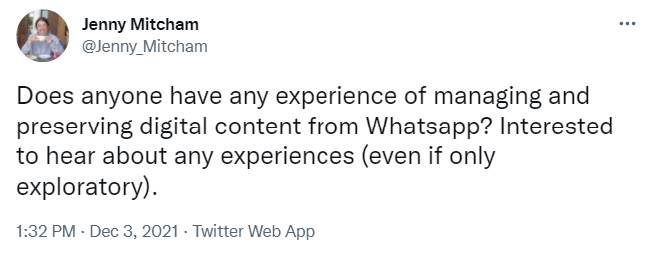Last week one of our monthly #DPClinic sessions focussed on the topic of preserving WhatsApp, an interesting subject that drew in a good crowd of people from the digital preservation community.
The session was triggered by a question from a DPC Member who was interested to find out how other organizations were tackling the challenge of WhatsApp preservation, in particular where it has been used for business functions and needs to be captured as a record. It was clear that this issue is a shared one and an emerging challenge for those working in digital preservation. There had previously been some discussion on Twitter on this topic with some really helpful replies to the question I posed.

Some of the challenges and issues with using WhatsApp for decision making were highlighted earlier this year in an article 'Covid public inquiry: Sloppy No 10 records and ‘government by WhatsApp’ could undermine probe, warn archivists' and a more recent report by The Institute for Government further highlights the problem 'WhatsApp in government'. The report mentions that “the speed and accessibility of WhatsApp means decisions can be made too quickly without the full facts or without sufficient input from key individuals” and also flags the importance of ensuring that WhatsApp conversations are fully captured as a record to be retained for the long term.
The conversation over the session went in several different directions.
WhatsApp has become incredibly widely used as a quick and efficient method of communication. It is so easy to send quick messages to friends and family (individuals or groups), but is it also being used in a work context? One question that was asked was how do digital archivists and information managers know whether WhatsApp is being used in their own organizations for business functions or decision making? Those working in information management or digital preservation may find out about it only by chance - perhaps through who they happen to share an office with, but it is not always easy to get a clear picture of who is using it for what.
Controlling use of messaging tools like WhatsApp can be a challenge. People tend to adopt the tools they like to use without necessarily considering the information management implications. If people already have WhatsApp on their phones and are using it outside of work, it is not hard to see how it could start being used to communicate with colleagues. One Member mentioned their ‘Acceptable use’ policy for WhatsApp (which more or less said it wasn’t acceptable to use it!) but still it can be incredibly difficult to manage or influence user behaviour. Internal advocacy around information management is really important here - and that should include not just a description of what is considered good practice, but the reasons why this is the case.
(As an aside, these conversations really reminded me of some of the discussions the EDRMS Preservation Task Force had last year whilst creating the EDRMS Preservation Toolkit - and yes, Microsoft Teams was also mentioned!)
Techniques for preserving WhatsApp were discussed. Some attendees mentioned asking individuals to save screenshots of selected WhatsApp conversations to their records management system, for example where a specific decision has been made. This is a fairly simple process that a user can easily be instructed to do and ensures that the record is captured in a basic form.
Discussion also turned to the export options for whole WhatsApp conversations. Some attendees had had a go at capturing or backing up their own WhatsApp messages. This can be done with or without the associated media (including all those animated gifs!) and can produce a useful export that adequately captures the chronology and structure of the messages. It was noted that the export function is limited to the attachment size of your email (which could be a problem if you have a lot of videos and images to export).
I personally didn’t have much luck in my quick and dirty attempt at backing up my WhatsApp messages to Google Drive and examining them. My phone says the job is done but I still can’t find them! Probably a textbook PEBKAC issue, but I didn’t have much time to devote to this exploration unfortunately!
Though the topic was brought up in the context of using WhatsApp for business functions, there are of course other reasons why digital archivists may need to consider preserving WhatsApp. As it has become so ubiquitous for personal use, it is likely to soon appear in personal digital archives that are deposited with us - alongside emails, photographs and other social media content.
The ethics of WhatsApp preservation and the consent of participants were briefly touched on but perhaps this is an even bigger conversation than the one about the technology…and not something we went into in detail.
There doesn’t seem to be much written on the topic of preserving WhatsApp at this point in time. This may be due to this being such a new area for the digital preservation community. It was noted in the DPClinic session that it is mentioned in a blog by Valerie Love of the National Archives of New Zealand on the topic of ‘Saving your social media’ though.
The session was summed up at the end by Rachel MacGregor from Warwick University who wisely noted “I suspect it's not the technology but the way we manage it all (as usual...) that's the key to this.”
So not many answers as such, but lots of food for thought. I’m assuming this won’t be the last we will hear on the topic of WhatsApp preservation!








































































































































